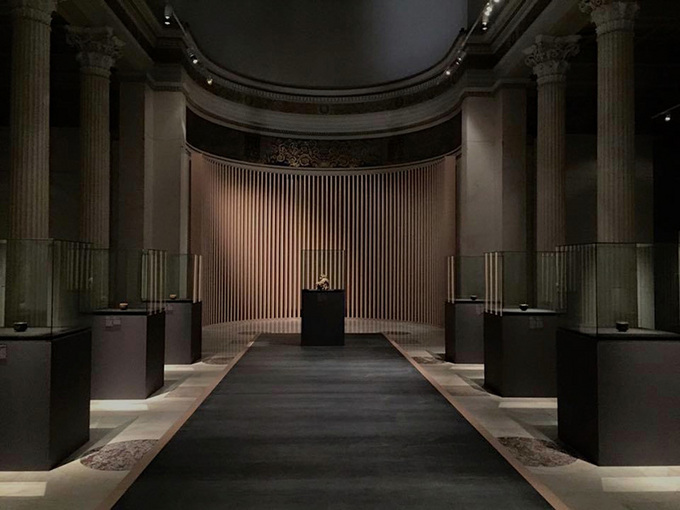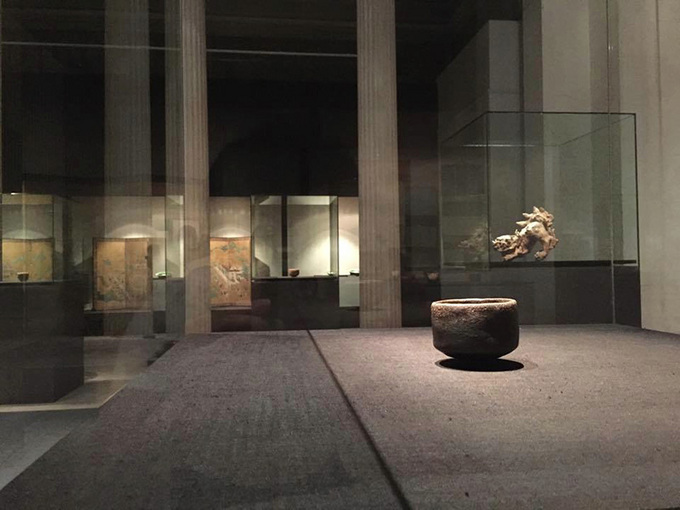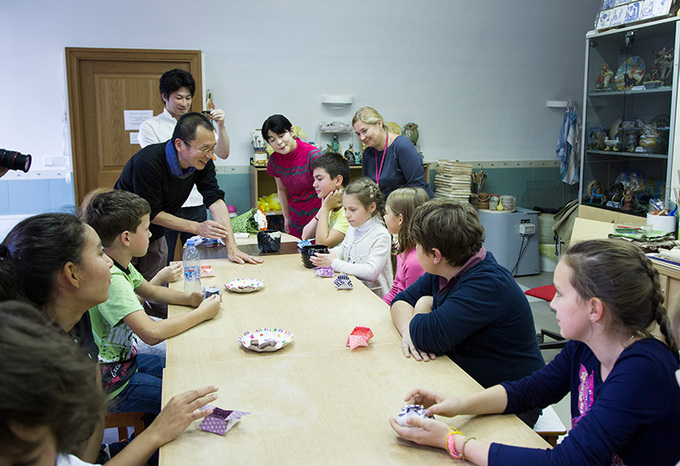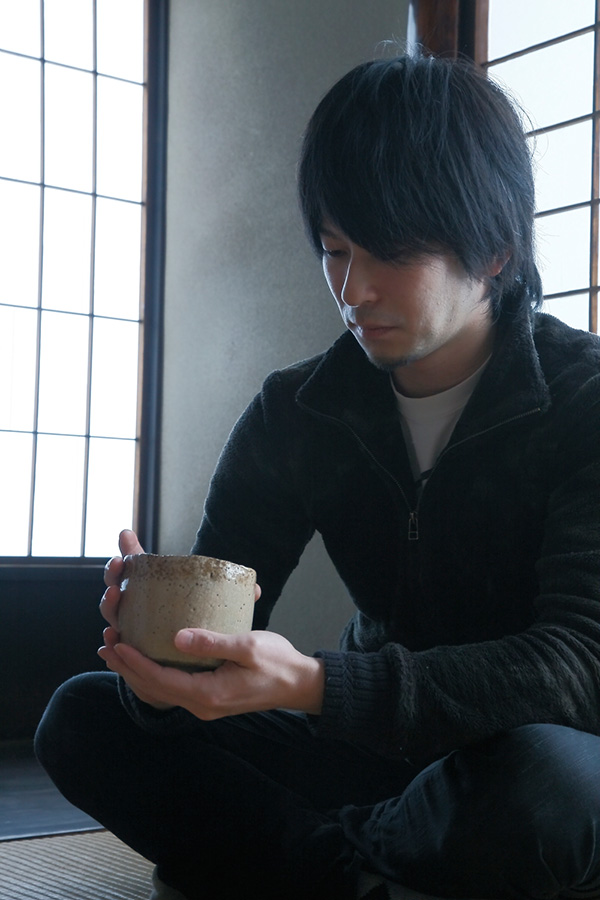Showing Raku Ware in Russia
Raku Atsundo (the future 16th head of the Raku Family)
The Japan Foundation and the Raku Museum jointly organized the exhibition Raku: The Cosmos in a Tea Bowl at the Los Angeles County Museum of Art in the United States of America from March through June 2015, and at the State Hermitage Museum and the Pushkin State Museum of Fine Arts in Russia from July through November of the same year. Artist Raku Atsundo, the creator of some of the pieces featured in the exhibition, traveled to Saint Petersburg and Moscow, and kindly contributed this article describing the local reactions to the exhibition and his interactions with Russian people.

The exhibition venue at the Pushkin State Museum of Fine Arts
What is Raku Ware?
Are you familiar with the pottery style called "Raku ware"?
There are many famous styles of pottery in Japan, such as Bizen, Shigaraki, and Arita. Raku is a style developed exclusively for the creation of objects used in the traditional Japanese tea ceremony.
Sen no Rikyū, one of the historical masters of tea ceremony, developed the style of wabi-tea, which emphasizes simplicity. He entrusted a potter called Chōjirō with the task of creating unique and innovative tea bowls that expressed the spirit of this style. This marked the birth of Raku ware.
Raku is a beloved ware in the world of Japanese tea ceremony, as described by the saying "Ichi-Raku, Ni-Hagi, San-Karatsu" ("First - Raku, Second - Hagi, Third - Karatsu"), which is the ranking of the three most popular brands of pottery for tea utensils. However, because Raku ware is almost exclusively used in the field of tea ceremony, people who are not involved in that field or do not know much about pottery are perhaps unfamiliar with Raku ware.
After all, Raku tea bowls (the black type) have no drawings or patterns on them and no colorful hues. They are just simple black tea bowls.
Exhibitions in Russia
I was invited by the Japan Foundation to exhibit Raku ware in Russia.
Raku ware? In Russia?
In recent years, I had grown used to holding exhibitions in many European countries and the U.S., but Russia was unknown territory for me. Despite the excessive information available to us in our modern world, the only image that my mind could conjure up upon hearing the name "Russia" was that of a country geographically close but otherwise quite distant from Japan.
And now I was being invited to exhibit Raku ware there.
Hmm...
If it had been a Raku tea bowl display held as part of a tea ceremony exhibition, the exhibition would provide supplemental information about the background of the birth of Raku ware and its connection with tea ceremony, making it easy to understand even for people who knew nothing about Raku.
As I mentioned above, Raku tea bowls are not widely known in Japan either. They are a special type of pottery, rarely encountered or used even by Japanese people, unless they have a special reason or opportunity to take a specific interest in Raku bowls.
Such opportunities, however, rarely arise. Taking advantage of this rare opportunity, we decided to exhibit our works in Russia. A plan was set in motion for a tour that consisted of exhibitions at a total of three venues: one in the U.S. (at the Los Angeles County Museum of Arts), and two in Russia (at the State Hermitage Museum in Saint Petersburg and the Pushkin State Museum of Fine Arts in Moscow).

Raku Chōjirō I. Black Raku tea bowl named Mozuya Guro [Mozuya Black] (front) and the two-color glazed lion figure (back)
What is "true essence"?
I was very anxious about how Russian people would perceive and understand the Raku tea bowls. Fortunately, once the exhibition opened its doors, not a single visitor raised their hands in exasperation, complaining that "I don't get this!" On the contrary, most visitors examined each single bowl meticulously and thoroughly read the explanations provided in the captions.
I was also surprised by the high quality of the questions I received.
Why are Raku bowls black? Why are they red?
The visitors were asking not about chemical techniques, but about the reason why the black Raku bowls had to be black and the red Raku bowls had to be red.
I also received questions about the relationship between the color of Raku bowls and the wabi-tea style.
Japanese people tend to accept things as they are, without asking such questions, but Russian people were different.
One Russian visitor explained that instead of negating cultures and concepts they do not understand, most Russian people take an interest in their true essence. This is a testament to their intellectual appetite.
What was the true essence they discovered in those small tea bowls that they had never seen before?
What I wanted them to feel through the exhibitions was the essence hidden in the tea bowls.
It is impossible to attain understanding through one-way communication, no matter how hard one tries.
These exhibitions reaffirmed my belief that true understanding can only be born when the two sides meet halfway.

Workshop led by Raku Kichizaemon and Raku Atsundo
Photo courtesy of the Pushkin State Museum of Fine Arts
The Future
Japan abounds with traditional culture, such as tea ceremony, flower arrangement, Noh, Kabuki, and Kyogen, to name but a few. Foreign people openly share their opinions and ideas as they search for the true essence of these traditions.
As artists, we must reexamine our understanding of what constitutes the "true essence" and our approach for conveying not merely the superficial beauty of Japan's traditional culture, but also its deep meaning, to those who are not Japanese, as well as to the children and young people who will forge the future of Japan.
 Raku Atsundo
Raku Atsundo
Born in 1981 as the eldest son of Raku Kichizaemon, current head and 15th generation of the Raku Family, Raku Atsundo (Sokichi) will one day succeed his father as the 16th generation master of Raku ware. After graduating as a Sculpture Major from the Department of Fine Arts at Tokyo Zokei University, he studied in London before returning to Japan where he is now engaged in creative work at the Raku Family workshop. Last year, prior to presenting his works in Japan, Raku Atsundo made his artistic debut at the exhibition Raku: The Cosmos in a Tea Bowl held at the Los Angeles County Museum of Art, the State Hermitage Museum (Saint Petersburg) and the Pushkin State Museum of Fine Arts (Moscow), presenting 12 of his signature red and black Raku tea bowls. As a curatorial advisor at the Raku Museum, he participates in exhibitions, and also engages in writing, creating explanations for the works of the successive heads of the Raku Family published in the book RAKU: A Legacy of Japanese Tea Ceramics (Seigensha Art Publishing).
Keywords
- Traditional Arts
- Handicraft
- Cultural Heritage
- Culture and Society
- Japan
- United States
- Russia
- Raku Museum
- Los Angeles County Museum of Art
- State Hermitage Museum
- Pushkin State Museum of Fine Arts
- Saint Petersburg
- Moscow
- Raku ware
- Bizen ware
- Shigaraki ware
- Arita ware
- Japanese tea ceremony
- Sen no Rikyū
- wabi-tea
- Chōjirō
- Raku tea bowls
- flower arrangement
- Noh
- Kabuki
- Kyogen
Back Issues
- 2024.11. 1 Placed together, we …
- 2024.5.24 The 50th Japan Found…
- 2024.5.24 The 50th Japan Found…
- 2024.2.19 Movie Theaters aroun…
- 2024.2.19 Movie Theaters aroun…
- 2023.4.24 The 49th Japan Found…
- 2022.10.24 Inner Diversity <2> …
- 2022.10. 5 Living Together with…
- 2022.6.13 The 48th Japan Found…
- 2022.6. 3 The 48th Japan Found…

